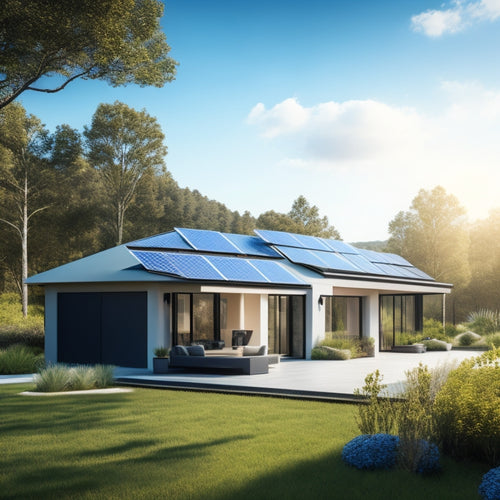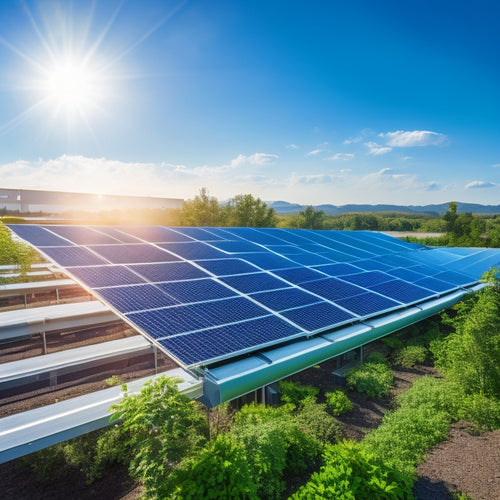
What Are the Downsides of Solar Panels on Your Roof
Share
As you contemplate installing solar panels on your roof, you'll want to weigh the benefits against the potential drawbacks. You'll need to evaluate the significant upfront costs, which can range from $15,000 to $30,000 or more, as well as the limitations on roof size and space. Energy storage and reliability issues can also impact your daily life, and weather dependence means you may face power shortages during adverse weather. Aesthetic concerns, maintenance needs, and energy loss are additional factors to reflect on. Understanding these downsides is essential for making an informed decision, and there's more to investigate when it comes to finding the right solar solution for you.
Key Takeaways
- High upfront installation costs and battery expenses can be a significant financial burden for homeowners, despite available incentives and financing options.
- Roof size and space limitations, including shading and complex designs, can hinder solar panel installation and efficiency.
- Energy storage and reliability issues, such as battery lifespan and charging time limitations, can affect the consistency of solar energy supply.
- Weather dependence and intermittency can lead to power shortages during adverse weather conditions, impacting the reliability of solar energy.
- Aesthetic and visual impact concerns, including panel size, color, and mounting systems, can detract from a property's appearance and curb appeal.
Higher Upfront Installation Costs
Higher upfront installation costs are a significant barrier to adopting solar panels as a renewable energy source.
You're likely to pay between $15,000 and $30,000 or more for a typical residential solar panel system, depending on the size and quality of the equipment. This hefty upfront investment can be intimidating, especially for homeowners on a budget.
However, you should consider that you can offset some of these costs through financing options and tax incentives. For instance, the Solar Investment Tax Credit (ITC) allows you to claim a tax credit of 26% of the total installation cost.
Additionally, many solar panel manufacturers and installers offer financing options with little to no down payment, making it more accessible to homeowners.
Roof Size and Space Limitations
While you're considering the financial implications of installing solar panels, it's also important to assess the physical constraints of your home. One significant limitation is the size and space of your roof. A general rule of thumb is that you'll need at least 100 square feet of unobstructed roof space per kilowatt of solar power you want to generate.
If your roof is too small or has multiple angles, you mightn't be able to fit enough panels to meet your energy needs.
Additionally, roof orientation plays a critical role in solar panel efficiency. South-facing roofs receive the most direct sunlight, making them ideal for solar panels. East- or west-facing roofs can still work, but north-facing roofs often receive too little sunlight to be effective.
Shading effects from trees, chimneys, or other obstructions can also reduce panel efficiency. Even if you have enough roof space, you'll need to guarantee that your panels receive sufficient sunlight to generate power.
Carefully evaluating these factors will help you determine whether solar panels are a viable option for your home.
Energy Storage Issues
As you consider integrating solar panels into your energy system, you'll face energy storage issues that can impact your overall experience.
You'll need to contend with the high upfront costs of batteries, which can be a significant expense.
Additionally, you'll need to account for charging time limitations and power output fluctuations that can affect the reliability of your energy supply.
Battery Cost Concerns
One major hurdle in adopting solar panels is the hefty price tag of energy storage systems, particularly batteries. As you contemplate installing solar panels on your roof, you'll need to factor in the cost of batteries to store excess energy generated during the day for use at night or during power outages.
The high upfront cost of these batteries can be a significant deterrent, especially for homeowners on a budget.
Another concern is the battery lifespan, which typically ranges from 10 to 15 years. Once the battery reaches the end of its lifespan, you'll need to replace it, adding to the overall cost of ownership.
Additionally, the recycling of spent batteries is still a developing industry, and the process can be complex and expensive.
As you weigh the benefits of solar panels against the drawbacks, it's crucial to evaluate the long-term costs associated with energy storage systems, including battery replacement and recycling.
Charging Time Limitations
Five to seven hours: that's the typical time it takes for a solar panel system to fully charge a battery from zero to 100%. This charging time limitation can be a significant drawback, especially if you're relying on solar power as your primary source of energy.
You might find yourself waiting for an extended period to get your battery back to full capacity, which can be frustrating, especially during periods of low sunlight or high energy demand.
The charging efficiency of your solar panel system plays a critical role in determining how quickly your battery charges. Factors such as the type and quality of your solar panels, the capacity of your battery, and the charging algorithm used can all impact charging efficiency.
Even with the latest advancements in solar technology, charging times remain a significant limitation. As you consider installing solar panels on your roof, it's important to understand these limitations and plan accordingly to guarantee you have a reliable source of power when you need it.
Power Output Fluctuations
Several factors can affect the power output of your solar panel system, and one of the most notable is power output fluctuations. This means that the amount of electricity your system generates can vary greatly throughout the day, even when the sun is shining brightly.
Power generation variability can occur due to various reasons, including:
-
Shading: Trees, buildings, or other obstacles can cast shadows on your solar panels, reducing their efficiency.
-
Dust and debris: Dirt, dust, and other particles on the surface of your solar panels can reduce their ability to convert sunlight into electricity.
-
Temperature changes: High temperatures can cause efficiency degradation, reducing the power output of your solar panels.
- Inverter limitations: The inverter, which converts DC power to AC power, can also impact the overall power output of your system.
These power output fluctuations can make it challenging to rely on your solar panel system as a stable source of power.
To mitigate this issue, it's crucial to evaluate energy storage solutions, such as batteries, to guarantee a consistent power supply.
Weather Dependence and Intermittency
Unpredictable weather patterns can greatly impact the performance of solar panels, rendering them an intermittent source of energy. You may experience fluctuations in power output due to cloud cover, which can reduce energy production by up to 90% on overcast days.
Additionally, seasonal variation affects the amount of sunlight your panels receive, resulting in lower energy output during winter months.
As you consider installing solar panels, it's vital to understand that you'll be relying on an energy source that's susceptible to weather conditions. This means you may not always have access to the power you need, especially during periods of prolonged cloud cover or extreme weather events.
Moreover, the intermittency of solar energy can make it challenging to guarantee a stable power supply, which may be a concern for you if you rely on electricity for critical systems or appliances.
It's important to weigh the benefits of solar energy against the potential drawbacks, including weather dependence and intermittency, to determine if it's the right choice for your energy needs.
Aesthetic Concerns and Visibility
You may find that solar panels can be an eyesore, detracting from your property's appearance.
The size and color of the panels themselves can be unappealing, and the mounting systems used to secure them can be obtrusive.
In addition, the installation patterns of the panels can also be visually unappealing, which may concern homeowners who value aesthetics.
Panel Size and Color
Your home's exterior appearance can greatly impact its curb appeal and resale value, which is why the size and color of solar panels can be a significant concern for homeowners considering solar energy.
While solar panels can be an attractive addition to your roof, they do come in varying sizes and colors that may or may not complement your home's aesthetic.
When it comes to panel size, larger panels often mean higher panel efficiency, but they can also be more noticeable on your roof.
On the other hand, smaller panels may be less obtrusive but could be less efficient.
In terms of color options, you'll typically find:
- Standard blue or black panels that blend in with most rooftops
- Premium black panels with a sleek, modern look
- Frames and clamps in silver or black to match your roof's trim
- Custom color options, although these may come at an additional cost
Ultimately, it's crucial to weigh the pros and cons of different panel sizes and colors to guarantee they align with your energy needs and personal preferences.
Obtrusive Mounting Systems
Beyond panel size and color, the mounting systems that secure solar panels to your roof can be a significant aesthetic concern, potentially detracting from your home's curb appeal. You may find that the mounting technology used in the installation affects the overall appearance of your roof. Some mounting systems can be bulky or obtrusive, drawing attention away from your home's design features.
| Mounting System | Aesthetic Impact |
|---|---|
| Rail-based systems | More visible, with rails and clamps adding bulk to the roof |
| Rail-less systems | Less visible, with a sleeker design that blends with the roof |
| Shared rail systems | A balance between visibility and sleekness, with shared rails reducing clutter |
| Integrated systems | Minimal visual impact, with the mounting system built into the panel frame |
When considering solar panels, it's crucial to evaluate the mounting technology used and its impact on your home's installation aesthetics. By doing so, you can ascertain that the solar panels blend seamlessly with your roof, maintaining your home's curb appeal.
Unappealing Installation Patterns
The arrangement of solar panels on your roof can greatly impact their visual appeal, with unappealing installation patterns potentially detracting from your home's overall appearance.
When it comes to installation design, a poorly planned layout can negatively affect the visual impact of your solar panels.
Some common issues that can lead to unappealing installation patterns include:
- Misaligned panels that create uneven lines and disrupt the roof's symmetry
- Inconsistent spacing between panels, which can create a cluttered appearance
- Panels that are installed too close to the roof's edge, making them more noticeable
- Visible electrical wiring or mounting hardware that can detract from the panels' sleek appearance
A well-designed installation can minimize the visual impact of solar panels and even enhance your home's curb appeal.
Roof Repair and Replacement Challenges
Installing solar panels on your roof can tie your hands when it comes to future repairs and replacements.
You'll need to take into account the added complexity of working around the panels, which can increase labor costs and time. This may lead to insurance implications, as your policy may not cover damages to the solar panels or the roof during repairs.
Additionally, warranty factors come into play, as some roofing warranties may be voided if solar panels are installed.
When the time comes to replace your roof, you'll need to factor in the cost of removing and reinstalling the solar panels. This can add thousands of dollars to the overall cost of the project.
Moreover, you may need to upgrade your roofing materials to guarantee they can support the weight of the solar panels, which can further increase costs.
It's crucial to weigh these challenges against the benefits of solar energy and take them into account in your overall decision-making process.
Inefficiencies and Energy Loss
Solar panels don't always operate at peak efficiency, and certain conditions can lead to energy loss. While they're designed to convert sunlight into electricity, system inefficiencies can reduce their performance.
You might experience energy degradation due to various factors, including:
-
Temperature: High temperatures can reduce your solar panel's efficiency. For every degree above 25°C, the panel's efficiency drops by about 0.4%.
-
Shading: Even partial shading can greatly reduce your system's energy output.
-
Dirt and debris: Dust, dirt, and other debris can block sunlight and decrease your panel's efficiency.
- Inverter limitations: The inverter, which converts DC power to AC, can also introduce energy losses.
These inefficiencies can add up, resulting in reduced energy output and lower-than-expected savings on your electricity bill.
To minimize energy loss, it's crucial to confirm your solar panel system is properly installed, maintained, and monitored. Regular cleaning and inspections can help optimize your system's performance and reduce energy degradation.
Battery Maintenance and Replacement
As you integrate energy storage into your solar panel system, considering battery maintenance and replacement becomes vital for peak performance. Neglecting these tasks can lead to reduced energy output, shortened battery lifespan, and even complete system failure.
To avoid these consequences, it's important to establish a maintenance schedule that includes regular checks on battery health, charge cycles, and capacity.
You should also factor in battery lifespan considerations, as most batteries have a limited number of charge cycles before their capacity begins to degrade. Typically, solar batteries last between 5-15 years, depending on the type and quality.
By tracking your battery's performance and adhering to the manufacturer's recommended maintenance schedule requirements, you can guarantee ideal energy storage and minimize the need for premature replacement.
Regular maintenance will also help identify potential issues before they become major problems. By staying on top of battery maintenance and replacement, you can maximize your solar panel system's efficiency, reduce energy losses, and enjoy a reliable source of power for years to come.
Frequently Asked Questions
Are Solar Panels Compatible With All Types of Roofing Materials?
You'll find that solar panels aren't compatible with all roofing materials, and installation challenges arise with certain types, such as slate, cedar, or asphalt shingles, requiring careful consideration of roofing compatibility before installation.
Can I Install Solar Panels on a Rented Property?
You're likely aware that 80% of Americans support solar energy, but can you install panels on a rented property? Typically, you'll need the renter's permission, and installation limitations may apply, so it's crucial to review your lease agreement and discuss options with your landlord.
Do Solar Panels Increase the Value of My Property?
You'll likely see an increase in your property's value, as a solar panel installation can enhance your property appraisal by 3-5% according to market trends, making your home more attractive to potential buyers if you decide to sell.
Can I Sell Excess Energy Generated Back to the Grid?
You can sell excess energy back to the grid through net metering policies, which measure your production and consumption, and energy buyback programs, allowing you to offset your energy costs and even earn credits.
Are Solar Panels Resistant to Natural Disasters Like Hurricanes?
When you install solar panels, you'll want to take into account hurricane preparedness; while they're designed to withstand harsh weather, installation risks arise if they're not securely fastened, so make certain your contractor follows local building codes and anchors them properly.
Conclusion
While solar panels can be a fantastic way to utilize renewable energy, it's crucial to reflect on the not-so-sunny side of the equation. Higher upfront costs, limited roof space, and energy storage issues can put a damper on your sustainability dreams. Add to that weather dependence, aesthetic concerns, and roof repair challenges, and it's clear that going solar requires careful thought. Still, with the right mindset and planning, you can maneuver these trade-offs and bask in the benefits of clean energy.
Related Posts
-

Evaluating Solar Power Options for Businesses
Evaluating solar power options for your business can greatly reduce energy costs and enhance sustainability. Start by...
-

Eco-Friendly Energy Storage Systems for Houses
Eco-friendly energy storage systems for your house let you capture and use renewable energy efficiently. You can choo...
-

Solar Energy Efficiency Improvements for Businesses
Improving solar energy efficiency for your business can lead to considerable cost savings and enhance your sustainabi...


